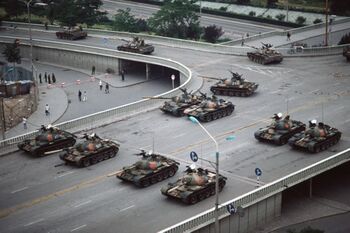1997 Daekanese coup d'etat
| 1997 Daekanese coup d'etat | |||||||
|---|---|---|---|---|---|---|---|
 Type 76 tanks of the 10th Mechanised Division in downtown Tayeong | |||||||
| |||||||
| Belligerents | |||||||
|
Supported by: |
Supported by: | ||||||
| Commanders and leaders | |||||||
|
|
| ||||||
| Strength | |||||||
| 30,000 DPA and MSS troops | 12,000 Tayeong Guards | ||||||
| Casualties and losses | |||||||
| 2 killed, 6 wounded | 8 killed, 15 wounded | ||||||
| 5 civillians killed, dozens wounded | |||||||
The 1997 Daekanese coup d'etat, also known as the July Coup, the Cadre Coup or the Restoration Revolution, was the successful seizure of power in Daekan by the Restoration Committee and its allied forces, against Premier Kwon Jung-Hoon. The coup lasted two days with minimal fighting, which nevertheless resulted in both military and civillian casualties.
The coup was orchestrated by the Restoration Committee, a group of Party, Ministry of State Security and Daekanese People's Army officials that had been alienated by Premier Kwon's reversal of his predecessor's (Maeng Song-Hun) Hyeogsin reforms, as well as the catastrophic fallout brought about from Kwon's aggressive foreign policy, specifically the involvement in the Esgonian Civil War. The Restoration Committee was made up of reformists that had been dedicated to Premier Maeng's policies of political and economic liberalisation, as well as opening up Daekan to the west. As such, the Committee became popularly known as the Maengist Cadre.
Background
Kwon rises to power and the Esgonian Civil War
Since his rise to power in 1990, Kwon Jung-Hoon had embarked on an aggressive form of foreign policy and military re-armament. Emboldened by the economic prosperity brought about Maeng Song-Hun's, Kwon's predecessor, reform policies of Hyeogsin (혁신; renovation), Kwon and his faction of the Communist Party sought to reaffirm Daekan's position in Eastern Ashai and the East Grey Sea. Among others, Kwon ordered the expansion of the naval re-armament and modernisation programme established by the National Defence Council in 1988, re-allocating a large portion of the government budget to the construction of new warships. Kwon also took a harsher stance against Esgonia, that was by 1993 on the verge of civil war. MSS First Directorate activity rapidly increased in the neighbouring country, with active subversion operations and support for underground left-wing organisations. Troop movements on the Esgonian border were also increased, as was the probing of Esgonian air defences by Daekanese aircraft.
The start of the Esgonian Civil War proper saw a significant amout of monetary and material support given to the communist Esgonian National Liberation Front. Advisors were also dispatched to train ENLF troops. As the war turned into a stalemate, Kwong ordered small Daekanese People's Army regulars to cross into ENLF-controlled areas, ignoring his advisors and other Party officials who advised against such a move. The government's official stance was that no DPA troops were in-country. As the ENLF started losing ground by 1994 and the Royalist faction was formed, DPA deployments intensified to the point where complete deniability was no longer possible, and as such these troops were dubbed "volunteers" and "internationalist fighters", with the DPA's precense becoming an open secret among the international community.
Return to totalitarianism
Daekanese involvement garnered a massive international reaction against the country. As the Esgonian Civil War ended with the defeat of the ENLF and othe rebel factions, the Daekanese public too turned against the intervention.